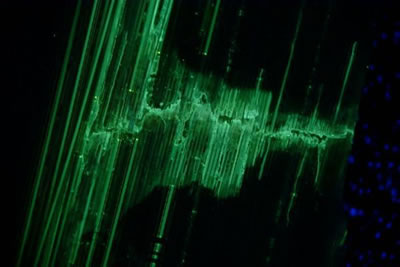Science Fiction
Dictionary
A B C D E F G H I J K L M N O P Q R S T U V W X Y Z
Self-Repairing Aircraft Mimic Borg Cubes

Aircraft using fiber-reinforced polymer (FRP) composites may be able to use a "self-healing" technique to repair cracks and small holes - even in flight.

(Fractured FRP with epoxy resin bleeding into damaged area (UV light))
Engineers at Bristol University, with funding from the Engineering and Physical Sciences Research Council (EPSRC) developed the technique. Here's how it works:
If a tiny hole/crack appears in the aircraft (e.g. due to wear and tear, fatigue, a stone striking the plane etc), epoxy resin would 'bleed' from embedded vessels near the hole/crack and quickly seal it up, restoring structural integrity.
The ingenious technique works by filling hollow glass fibers contained in FRP composites with special epoxy resin and hardener. If there is a break, the resin flows out, sealing the damaged area, and then hardens. The picture shown above illustrates how the epoxy resin bleeds into the damaged area.
"This approach can deal with small-scale damage that's not obvious to the naked eye but which might lead to serious failures in structural integrity if it escapes attention," says Dr Ian Bond, who has led the project. "It's intended to complement rather than replace conventional inspection and maintenance routines, which can readily pick up larger-scale damage, caused by a bird strike, for example."
I've written about this kind of technique before; see these articles on Nanotech Self-Healing Houses and Self-Healing Polymer Autonomous Material System for variations on self-healing materials. SF author JG Ballard wrote about a material with similar uses in self-healing houses; he called it plastex.
Update 28-Apr-2012: In his 1951 novel Asteroid of Fear, Raymond Z. Gallun wrote about self-sealing plastic that was used in space to protect against damage by micrometeorites.
It even had an inter-skin layer of gum that could seal the punctures that grain-of-sand-sized meteors might make.
End update.
As far as it's use in aircraft is concerned, this kind of material may remind readers of the self-healing Borg cubes; the process can be seen at about 2'40" into the following video:
(Borg cube repairs itself [starting at 2:40])
Via Self-repairing Aircraft Could Revolutionize Aviation Safety; thanks to Moira for the tip. (Note to Moira: thanks for the tip on Iron Man biological circuit fabrication. I did like the article - I wrote it! Xinhuanet stole the article verbatim from a version printed with permission on LiveScience.com.)
Scroll down for more stories in the same category. (Story submitted 5/19/2008)
Follow this kind of news @Technovelgy.| Email | RSS | Blog It | Stumble | del.icio.us | Digg | Reddit |
Would
you like to contribute a story tip?
It's easy:
Get the URL of the story, and the related sf author, and add
it here.
Comment/Join discussion ( 0 )
Related News Stories - (" Vehicle ")
Inmotion Electric Unicycle In Combat
'It is about the size and shape of a kitchen stool, gyro-stabilized...' - Robert Heinlein, 1940.
Congress Considers Automatic Emergency Braking, One Hundred Years Too Late
'The greatest problem of all was the elimination of the human element of braking together with its inevitable time lag.' - Bernhard Brown, 1934.
The 'Last Mile' In China Crowded With Delivery Robots
Yes, it's a delivery robot. On wheels.
Musk Idea Of Cars Talking To Each Other Predicted 70 Years Ago
'My cars talk to one another.' - Isaac Asimov, 1953.
Technovelgy (that's tech-novel-gee!) is devoted to the creative science inventions and ideas of sf authors. Look for the Invention Category that interests you, the Glossary, the Invention Timeline, or see what's New.
Science Fiction
Timeline
1600-1899
1900-1939
1940's 1950's
1960's 1970's
1980's 1990's
2000's 2010's
Current News
Golf Ball Test Robot Wears Them Out
"The robot solemnly hit a ball against the wall, picked it up and teed it, hit it again, over and again...'
Boring Company Vegas Loop Like Asimov Said
'There was a wall ahead... It was riddled with holes that were the mouths of tunnels.'
Rigid Metallic Clothing From Science Fiction To You
'...support the interior human structure against Jupiterís pull.'
Is The Seattle Ultrasonics C-200 A Heinlein Vibroblade?
'It ain't a vibroblade. It's steel. Messy.'
Roborock Saros Z70 Is A Robot Vacuum With An Arm
'Anything larger than a BB shot it picked up and placed in a tray...'
A Beautiful Visualization Of Compact Food
'The German chemists have discovered how to supply the needed elements in compact, undiluted form...'
Bone-Building Drug Evenity Approved
'Compounds devised by the biochemists for the rapid building of bone...'
Secret Kill Switch Found In Yutong Buses
'The car faltered as the external command came to brake...'
Inmotion Electric Unicycle In Combat
'It is about the size and shape of a kitchen stool, gyro-stabilized...'
Grok Scores Best In Psychological Tests
'Try to find out how he ticks...'
PaXini Supersensitive Robot Fingers
'My fingers are not that sensitive...'
Congress Considers Automatic Emergency Braking, One Hundred Years Too Late
'The greatest problem of all was the elimination of the human element of braking together with its inevitable time lag.'
The Desert Ship Sailed In Imagination
'Across the ancient sea floor a dozen tall, blue-sailed Martian sand ships floated, like blue smoke.'
The Zapata Air Scooter Would Be Great In A Science Fiction Story
'Betty's slapdash style.'
Thermostabilized Wet Meat Product (NASA Prototype)
There are no orbiting Michelin stars. Yet.
Could Crystal Batteries Generate Power For Centuries?
'Power could be compressed thus into an inch-square cube of what looked like blue-white ice'
